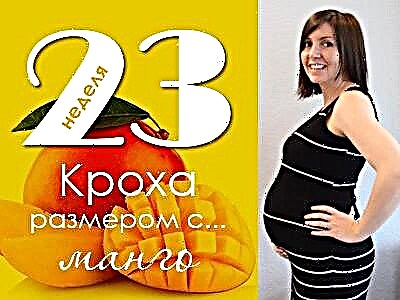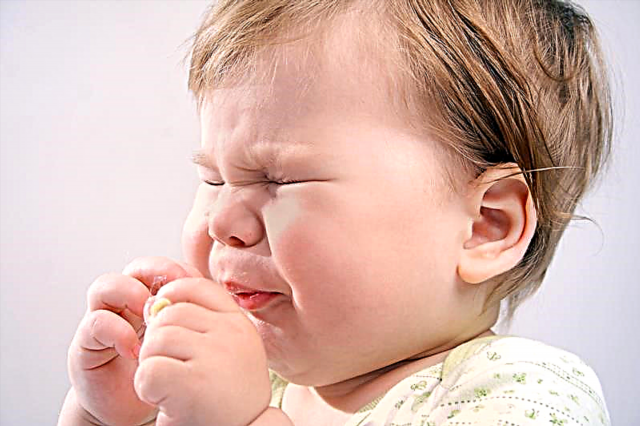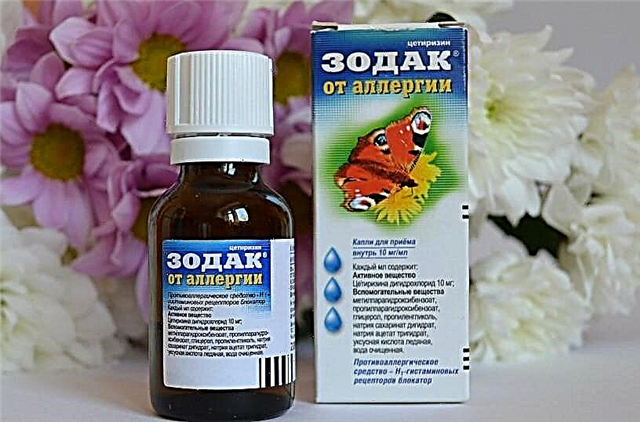
Sore throat, hoarseness, perspiration and other symptoms of sore throat, acute respiratory infections, pharyngitis and some other diseases are often treated with local remedies. Such medicines are tablets and lozenges for sucking, throat irrigation, gargling solutions. All of them reduce painful sensations, moisturize and soften the mucous membrane. Hexoral also belongs to such drugs with local action. Can it be used for children and how to do it correctly?

Release form
The drug is available in pharmacies in various forms.
Solution
It is a red transparent liquid with a mint smell. Since it is sweet, some parents call this form syrup. The solution is placed in a 200 ml glass bottle and supplemented with a measuring beaker.
Spray
It is a light transparent liquid with menthol aroma, placed inside an aluminum cylinder. The package contains 1 spray nozzle, but there is also a spray for the family, in the package of which 4 nozzles of different colors are attached to the aerosol can.
Pills
Available in several versions. For example, Hexoral tabs are round, rough, white (can be yellow or gray), convex on both sides of the tablet. They can be unevenly colored, with uneven edges, air bubbles or white bloom - these changes do not impair the properties of the medicine. One pack contains 20 tablets.
Another type is Hexoral Tabs Classic. These tablets are available in different flavors: lemon, orange, black currant, honey with lemon, they are packed in packs of 8, 16 or 24 pieces.
Also in the assortment of the manufacturer there are Hexoral Tabs Extra tablets. They are also available in 4 different flavors and are packaged in boxes of 8-24 tablets.

Composition
The active substances in liquid Hexoral and tablet medicine are different. The main component of the aerosol and solution, providing an antiseptic effect, is represented by hexetidine. The solution contains 0.1 g of such a substance per 100 ml of the drug, therefore its concentration is 0.1%. The concentration of the spray is 0.2%, that is, in 100 ml of the contents there is 0.2 g of hexetidine.
Additionally, the aerosol contains levomenthol, 96% ethanol, eucalyptus oil, citric acid, water, nitrogen, saccharinate and sodium hydroxide. This form also includes polysorbate 80 and sodium calcium edetate. Anise, clove, eucalyptus and peppermint oil are auxiliary components of the solution. In addition, this preparation contains methyl salicylate, polysorbate 60, 96% ethyl alcohol, water, sodium saccharin, citric acid and levomenthol. The color of the solution is due to the E122 dye (azorubin).
The tablets contain several active substances at once. In Hexoral tabs, these are benzocaine (1.5 mg in 1 tablet) and chlorhexidine in the form of dihydrochloride (5 mg per tablet). In addition to these ingredients, the medication contains aspartame, isomalt, peppermint oil, water, menthol and thymol.
For information on how to properly gargle, see the video.
As part of Classic tablets dichlorobenzyl alcohol (1.2 mg per tablet) supplemented with amylmetacresol (0.6 mg per tablet). Auxiliary substances of any kind of this drug are sucrose, peppermint oil, dextrose and citric acid. The flavors and colorants in different tablets differ, for example, blackcurrant flavors, brilliant blue and azorubin dyes are present in blackcurrant, and quinoline yellow dye, anise oil and lemon oil concentrate in lemon.
Extra tablets also contains dichlorobenzyl alcohol and amylmetacresol in the same concentration as in the Classic preparation, however, they are supplemented with lidocaine hydrochloride (10 mg per 1 tablet). The auxiliary components of this medication are practically the same as in Classic tablets.

Operating principle
Hexetidine in liquid forms of the drug has a broad spectrum of action against many bacteria, fungi and some viruses. Local treatment with such a drug leads to the suppression of metabolic reactions in the cells of pathogens. The drug is effective against candida, gram-positive microbes, RS viruses, pseudomonas and many other infectious agents. Also, this antiseptic has some analgesic effect.
The effect of Hexoral tabs can be seen already 15-30 seconds after the tablet enters the mouth.
The active substances of this medication are represented by an antiseptic and anesthetic, so the medication affects bacteria and at the same time reduces pain symptoms. In Classic tablets, active compounds have an antiseptic effect, and Extra not only fights bacteria, but also reduces pain and swelling.

Indications
Local application of Hexoral is recommended:
- With stomatitis, periodontal disease, gingivitis, periodontal inflammation and other dental pathologies, as well as after tooth extraction and other surgical procedures in the mouth.
- With angina, laryngitis, pharyngitis, acute respiratory infections and other infectious and inflammatory lesions of the throat.
- With candidiasis of the oral cavity.
- After injury or surgery on the larynx and tonsils.
- For hygienic treatment of the oral cavity with an unpleasant odor.


From what age is it allowed to take?
Liquid forms of medication are prohibited under the age of 3 years. Tablets are prescribed for children over 4 years old (Hexoral tabs), 6 years old (Classic) and 12 years old (Extra). Rinsing a one-year-old child or injecting an aerosol at the age of 1 year is not allowed.
Even if the baby is already 3 years old, only a doctor should prescribe a solution or spray up to the age of six. The pediatrician will assess whether topical treatment can be performed and then determine the frequency of treatment. For example, the condition for using the solution is that there is no risk of accidental swallowing (after rinsing the solution should be spit out), and in order to use the spray, the child must be able to hold his breath.

Contraindications
It is impossible to use the medicine in the treatment of children in a situation where the child's body reacts to Hexoral with allergies or other side effects. Treatment is contraindicated in case of erosions or ulcers on the mucous membrane of the oropharynx. The solution should be used with caution in children with acetylsalicylic acid intolerance. The tablets are not used for phenylketonuria and low blood cholinesterase concentrations.
Side effects
Topical application with a spray or solution rarely causes a burning sensation, irritation or inflammation. In some children, the drug changes the color of the tongue and teeth, and also provokes the formation of ulcers or vesicles on the mucous membrane. Resorption of tablets, in addition to these symptoms, can cause numbness of the tongue, taste disturbances, decreased sensitivity in the mouth and the appearance of tartar.
Very rarely, the use of Geksoral leads to shortness of breath, urticaria, vomiting, coughing and other symptoms. If such a negative reaction to treatment is revealed in a small patient, the drug is canceled and a doctor is consulted about symptomatic treatment and replacement of the remedy.

Instructions for use and dosage
- The solution is poured into a measuring glass in the amount of 15 ml, and then rinse a child over six years old (for example, at the age of 7 years) two or three times a day. It is not necessary to dilute the medicine with water, and the duration of the procedure should be at least 30 seconds. In addition, lotions can be made with a solution. To do this, the drug is applied to a tampon and applied to the area requiring treatment for 2-3 minutes.
- The spray in the treatment of children over 6 years old is used twice a day. Processing is carried out after meals. For spraying, a nozzle is installed on the balloon, and then, holding the bottle vertically, the nozzle should be inserted into the oral cavity and directed to the place to be treated. After asking the child to hold his breath, press on the head of the nozzle and inject a spray into the oropharynx for 1-2 seconds.
- Geksoral tabs should be absorbed in the oral cavity for a long time until the tablet is completely dissolved by saliva. A child aged 4-12 years is prescribed 4 tablets daily, and children over 12 years old can be given up to 8 tablets per day. You can dissolve the drug one tablet every 1-2 hours.
- The drug Classic is prescribed to a child over six years old, one tablet. It is permissible to dissolve it with an interval of 2-3 hours, but not more than eight tablets per day.
- Extra tablets are also prescribed up to 8 pieces per day. You can dissolve such a medicine for children over 12 years old every 2-3 hours, 1 tablet.
- How many days to take the drug should be agreed with the doctor, because with some pathologies, several days of local treatment are enough, while others require long-term use.


Overdose
Exceeding the dose of a spray or solution may cause intoxication with ethyl alcohol. In case of an overdose of benzocaine tablets in their composition, they can have a toxic effect on the central nervous system, which is manifested by vomiting, seizures or tremors, and then depression and coma. At a very high dose of the drug, methemoglobinemia, bradycardia, or cardiac arrest may occur.
If a child has swallowed a lot of the drug and this was detected within two hours after the incident, the stomach should be flushed and then a doctor should be consulted. If the condition is serious, the baby will need hospital treatment.
Interaction with other drugs
In the annotation to the aerosol and solution, there is no information about the impossibility of combining such drugs with other medications. The tablets are not recommended to be combined with aminosalicylates and sulfonamides, since benzocaine has the property of reducing their antibacterial effect. When combining tablets with drugs that contain calcium, zinc, magnesium salts, polysorbate 80 or sucrose, the effect of chlorhexidine will be blocked.

Terms of sale
Any form of Hexoral is a non-prescription drug. The average price of a package of tablets is 160-180 rubles, one bottle of solution is about 240-260 rubles, and one bottle of spray is about 300 rubles.
Storage conditions and shelf life
Store the spray, tablets or solution at home at temperatures up to +25 degrees. Keep the medicine out of the reach of babies. With the storage of the aerosol, you need to be especially careful. Since the contents of the container are under pressure, it is forbidden to open the package or burn the bottle, even if the liquid is completely consumed.
The shelf life of the solution is up to 2 years from the date of production, aerosol and Hexoral tabs tablets - 3 years, Classic and Extra tablets - 4 years. As soon as the spray is used for the first time, the container can be stored for no longer than 6 months. Six months after the first use, the drug must be discarded, even if the contents still remain.
Reviews
Mothers who have used Hexoral in their children leave mostly good reviews about such a medicine. In them, they mention the high effectiveness for pain and sore throat. Most often, a solution or spray is chosen for treatment.
Parents praise the liquid form for its ease of use and rare side effects. According to moms, allergies, burning sensations and other negative symptoms occur very rarely with hexetidine. Most children tolerate the taste of the medicine well, but sometimes they don't like it. Many mothers call the cost of the medication acceptable, but sometimes they prefer cheaper funds.


Analogs
You can replace Geksoral in liquid form with other drugs, including hexetidine:
- 0.1% solution or 0.2% Stopangin aerosol. The drug can be used from 6 years old.
- A solution of Stomatidin, used for rinsing from the age of five.
- 0.2% Maxicold Lor spray, which can be used to treat children over 3 years old.
Also, for local treatment, the doctor may recommend other agents that are classified as antiseptics and antimicrobials. Among them are Ingalipt, Miramistin, Tantum Verde, Yoks, Oralsept, Lugol, Hexasprey and other drugs. Any of these drugs has its own nuances of use, so it is better to select an analogue together with a doctor.
Surely you will be interested to know what Dr. Komarovsky thinks about such an ailment in children as angina:



